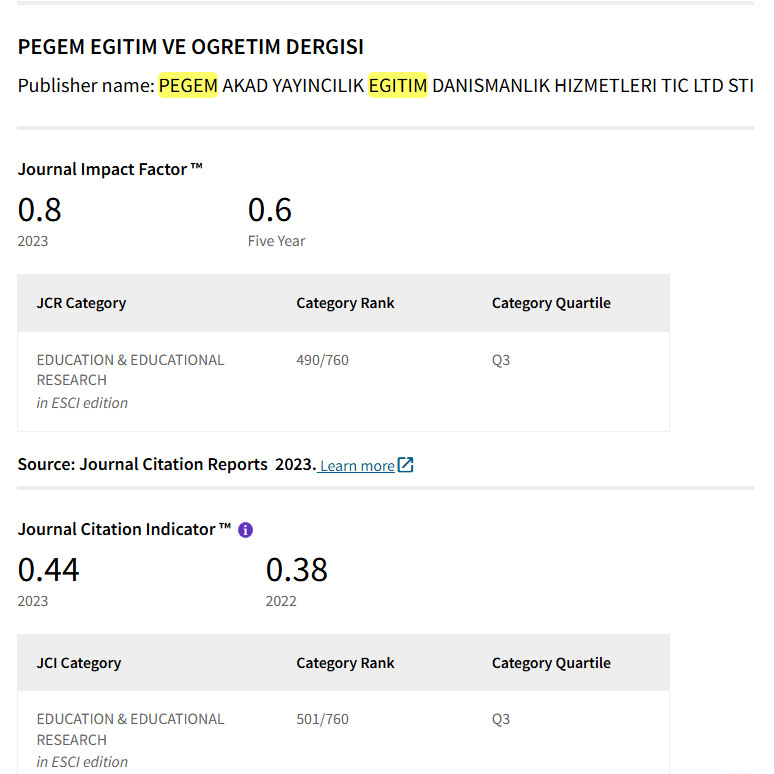The Effect of Mathematical Intelligence Stick Media on the Summation Skills of Students with Intellectual Disability
DOI:
https://doi.org/10.47750/pegegog.13.03.21Keywords:
mathematical intelligence stick, summation, children with intellectual disabilityAbstract
Children with intellectual disabilities face obstacles in their numeracy skills development. Stick intelligence is a learning media that is aimed to help these children enhance their numeracy skills. Therefore, this study aims to identify (1) the numeracy skills of students with intellectual disabilities before using the mathematical intelligence sticks, (2) the numeracy skills of students with intellectual disabilities after using the mathematical intelligence sticks, and (3) the effects of mathematical intelligence stick media in enhancing the numeracy skills of fourth-grade students with intellectual disability in State Elementary School for Exceptional Children 4 Batu, Indonesia. This experimental study used single-subject research (SSR) approach with an A-B-A design. The data were obtained by asking the students to complete the summation operation, and the results were analyzed using percentages. The analysis results showed that (1) the initial mean level of the numeracy skills of the children with intellectual disabilities was 52.2; (2) the mean level of the numeracy skills of the children with an intellectual disability after the treatment was 82.3; and (3) mathematical intelligence sticks carry effects on the numeracy skills of the children with intellectual disability. Therefore, an increase in summation skills of the students with intellectual disabilities is attained after they use the mathematical intelligence stick.
Downloads
References
Ardhianto, E, dkk. 2012. Augmented Reality Objek 3 Dimensi dengan Perangkat Artookit dan Blender. Dinamika: Jurnal Teknologi Informasi. Dari http://https://www.unisbank.ac.id/ojs/index.php/fti1/article/view/1658
Arsyad, Azhar. 2003. Media Pembelajaran. Jakarta: PT Grafindo
Azwar, Saifuddin. 2013. Reliabilitas dan Validitas. Yogyakarta: Pustaka Pelajar.
Effendi, Mohammad. Pengantar Psikopedagogik Anak Berkelainan. Jakarta: Bumi Aksara.
Grobogan. (online), (http:repository.uksw.edu/handle/12345678 9/1359) diakses17 April 201
Hendra, J. 2012. Meningkatkan Kemampuan Operasi Hitung Penjumlahan Dengan Pembelajaran Matematika Realistik Pada Anak Tunagrahita Sedang. Jurnal Ilmiah
Hidayat, R.A. 2014. Pengaruh Penggunaan Media Stick Eskrim Terhadap Prestasi Belajar Operasi Penjumlahan Anak Tunagrahita Kelas V SLB Putra Jaya. Skripsi tidak diterbitkan. Malang: PLB UM
Hidayati, Enik. 2015. Peningkatan Kemampuan Operasi Penjumlahan dan Pengurangan Bilangan dengan Menggunakan Media Garis Bilangan pada Mata Pelajaran Matematika Siswa Kelas II MI Mambaul Hikmah Mojokerto. Digital Library. Dari http://https://digilib.uinsby.ac.id/3414/
Iriyanto, Tomas., & Styningrum, T.L. 2014. Pengaruh Penggunaan Media Dakon Terhadap Kemampuan Operasi Penjumlahan Siswa Kelas IV Tunagrahita Di SLB. Jurnal Ortopedagogia, 1(2), 140-145
Kustiawan, Usep. 2016. Pengembangan Media Pembelajaran Anak Usia Dini. Malang: Gunung Samudra
Mumpuniarti & Pujaningsih. 2016. Pembelajaran Akademik Fungsional dalam Konteks Pendidikan Khusus Orientasi Budaya, Edisi 1. Yogyakarta: UNY Press.
Nugrahani, R. 2007. Media Pembelajaran Berbasis Visual Berbentuk Ular Tangga Untuk Meningkatkan Kualitas Belajar Mengajar Di Sekolah Dasar. Lembaran Ilmu Kependidikan Journal Of Educational Research. Dari http://https://journal.unnes.ac.id/nju/index.p hp/LIK/article/view/524
Pendidikan Khusus. Dari http://http://ejournal.unp.ac.id/index.php/ju pekhu/article/view/849.
Soendari, T. 2006. Pendekatan Realistik dalam Meningkatkan Kemampuan Matematika Anak Tunagrahita Ringan Di sekolah Luar Biasa. Laporan Penelitian Mandiri. Bandung: PLB FIP UPI
Sulistiyowati. 2012. Pemanfaatan Alat Peraga Benda Kongkret Untuk Meningkatkan Meningkatkan Hasil Belajar Matematika Tentang Pengukuran Pada Siswa Kelas II Semester 1 SD Negeri Wonosari Kabupaten
Sunanto, J, dkk. 2006. Penelitian dengan Subjek Tunggal. Bandung: UPI
Wardani. 2012. Studi Perbandingan Penggunaan Dekak-Dekak dengan Penggunaan Potongan Batang Lidi Terhadap Hasil Belajar Matematika Siswa Kelas 1 SDN Gadang 4 Kota Malang. Skripsi tidak diterbitkan. Malang: KSDP UM
Downloads
Published
How to Cite
Issue
Section
License
Copyright (c) 2023 Pegem Journal of Education and Instruction

This work is licensed under a Creative Commons Attribution-NonCommercial 4.0 International License.
Attribution — You must give appropriate credit, provide a link to the license, and indicate if changes were made. You may do so in any reasonable manner, but not in any way that suggests the licensor endorses you or your use.
NonCommercial — You may not use the material for commercial purposes.
No additional restrictions — You may not apply legal terms or technological measures that legally restrict others from doing anything the license permits.



